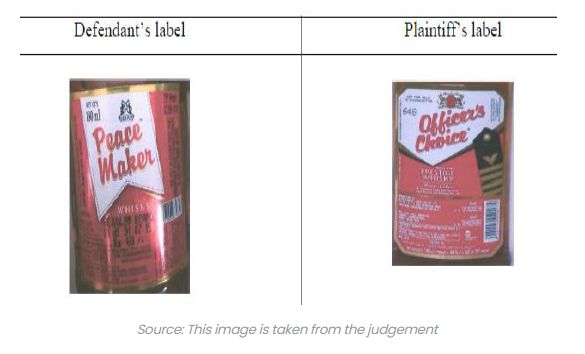Trademarks play a vital role in consumer awareness by helping customers recognise and differentiate between products and services in the marketplace. They serve as indicators of quality, consistent standard, and origin, allowing consumers to make informed purchasing decisions. Additionally, trademarks foster brand loyalty and trust among consumers, contributing to the overall success and reputation of businesses.
UNDERSTANDING TRADEMARKS
Trademarks are distinctive symbols, names, words, sounds, shapes, or phrases used to identify and distinguish the goods or services of one seller from those of others in the marketplace. The primary purpose of trademarks is to indicate the origin and prevent consumer confusion and deception by enabling consumers to recognise and trust specific brands or products.
IMPORTANCE OF TRADEMARK REGISTRATION
Trademark registration provides legal recognition and protection to owners by granting exclusive rights to use the trademark in connection with specific goods or services. A registered trademark right holder has statutory remedies, both civil and criminal, in case of violation of their trademark rights.
RIGHTS AND RESPONSIBILITIES OF TRADEMARK OWNERS
Trade Mark owners get exclusive rights of commercial exploitation. While adopting a trademark one must ensure that its mark is unique and is not similar to another trademark. The mark must not create confusion regarding the origin of the goods or services. Honesty in adoption is an essential criterion. .
TRADEMARK PROTECTION
A trademark owner must always be vigilant in protecting its mark.
Any attempt to usurp its mark by another businessman must be stopped whenever it comes to knowledge. Oppositions can be filed before Trade Mark Offices if identical or similar marks are applied by other entities
Trademark infringement occurs when a third party uses a mark that is identical or similar to a registered trademark in connection with similar goods or services, leading to consumer confusion and dilution of brand value. Trademark owners can protect their rights by enforcing their trademarks through legal actions, such as cease and desist letters, infringement lawsuits,.
Trademark protection aims to safeguard the reputation and goodwill associated with a trademark, ensuring that consumers can trust the origin and quality of the goods or services bearing the mark. It also promotes fair competition in the marketplace by preventing unauthorised use of established trademarks.
THE INTERFACE BETWEEN TRADEMARK PERCEPTION AND CONSUMER AWARENESS
Trademarks leave a profound psychological impression on consumers, shaping their perceptions and attitudes towards specific brands or products. The visual elements, colours, fonts, sounds, shape, smell and overall impact of trademarks evoke emotions and associations that influence consumer behaviour and purchasing decisions.
Trademarks serve as badges of origin, indicating the source or manufacturer of goods or services. They distinguish one brand from another and convey the reputation, quality, and authenticity associated with the trademark owner. Consumers rely on trademarks to identify and trust products they have previously experienced or heard about, establishing a sense of familiarity and consistency.
INFLUENCE OF TRADEMARK AWARENESS ON CONSUMER DECISION MAKING
Instantaneous decision-making: In today's fast-paced consumer environment, trademark awareness plays a crucial role in instantaneous decision-making. Consumers often make split-second judgments based on their recognition and perception of trademarks, especially in crowded marketplaces with numerous competing products and services. A familiar trademark can signal reliability and familiarity, prompting consumers to choose a trusted brand over unfamiliar alternatives.
Importance of trademark recognition: Trademark recognition is essential for consumers to make informed and confident purchasing decisions. Recognisable trademarks help consumers navigate through vast product offerings, enabling them to quickly identify preferred brands and differentiate between genuine products and imitations or counterfeit goods. Strong trademark recognition fosters consumer loyalty and repeat purchases, as consumers develop positive associations and trust towards recognised brands.
A recent case before the Delhi High Court involved a dispute between Hermes Distillery Pvt. Ltd. and Allied Blenders and Distillers Pvt. Ltd. The controversy revolved around the similarity of trade dress and get up between the PEACE MAKER and OFFICER'S CHOICE labels used for liquor bottles. Allied Blenders alleged that Hermes Distillery's PEACE MAKER labels imitated key features of its OFFICER'S CHOICE labels, leading to confusion among consumers.

The court's decision favoured Allied Blenders, granting an injunction against Hermes Distillery from using the PEACE MAKER labels for its alcoholic beverages. The court found that the similarities between the two labels were significant enough to cause confusion among consumers, thereby infringing on Allied Blenders' trademark rights
Importance of Legal Protection for Trademarks
Legal frameworks play a vital role in upholding the integrity of trademarks and preserving brand reputation. Trademark registration provides owners with exclusive rights to use their marks, enabling them to take legal action against unauthorised use or infringement. By enforcing trademark laws, businesses can protect their investments in branding and maintain their competitive advantage in the marketplace.
The Delhi High Court judgement serves as a reminder of the importance of legal protection for trademarks in preserving brand identity and consumer trust. Through robust legal frameworks and vigilant enforcement, businesses can safeguard their trademarks and uphold their commitment to quality, consistency, and consumer satisfaction.
MITIGATING DECEPTIONS IN TRADEMARK USAGE
In trademark usage, implementing strict mechanisms is paramount to uphold the integrity of brands and mitigate potential deceptions in the marketplace. These mechanisms encompass the following facets:
MARKET CONTROLS
Market controls involve monitoring and regulating the distribution and sale of products to ensure compliance with trademark laws and prevent unauthorised usage. By implementing robust monitoring mechanisms, authorities can identify and address instances of trademark infringement or counterfeit goods effectively.
LEGAL PROVISIONS
Legal provisions serve as the backbone of trademark protection, providing a framework for enforcing trademark rights and holding infringers accountable. Legal mechanisms such as trademark registration, infringement lawsuits, injunctions and punishments under criminal law play a crucial role in deterring dishonest use of trademarks and safeguarding brand integrity.
AWARENESS PROGRAMMES
Educational initiatives and awareness programmes are instrumental in fostering understanding and compliance with trademark laws among businesses, consumers, and other stakeholders. By raising awareness about the importance of trademarks, their legal implications, and the consequences of infringement, these programmes empower individuals to make informed decisions and contribute to a culture of respect for intellectual property rights.
PREVENTING DISHONEST USE OF TRADEMARKS
Preventing dishonest use of trademarks requires a multifaceted approach that combines proactive measures with swift enforcement actions. Businesses must remain vigilant in monitoring their trademarks and promptly address any instances of unauthorised use or infringement. This may involve conducting regular audits, implementing trademark monitoring services, and actively monitoring online platforms for unauthorised usage.
Moreover, collaboration with law enforcement agencies, intellectual property offices, and industry associations can strengthen efforts to combat trademark infringement and counterfeit goods effectively. By fostering partnerships and sharing information and resources, stakeholders can amplify their impact and create a hostile environment for counterfeiters and infringers.
THE IMPACT OF BRAND CONSISTENCY
Brand consistency is paramount in maintaining a strong and recognisable identity in the marketplace. It entails ensuring uniformity in brand elements such as logos, colours, messaging, and overall brand experience across different touchpoints. Consistency enhances brand recall, fosters consumer trust, and reinforces brand associations over time.
CONSEQUENCES OF CONFUSION IN BRAND IDENTIFICATION
Point of Sale Confusion:
The common type of trademark infringement is known as "passing off" or "point-of-sale confusion." This happens when the defendant uses the plaintiff's trademark or a deceptively similar trademark on their own goods to trick customers into believing that the goods came from the plaintiff. At the point of sale, consumers may encounter confusion when differentiating between similar brands or products, leading to decision-making dilemmas and potential loss of sales for the genuine brand owner. This can happen due to:
- Similar trademarks: Names, logos, slogans, or any other elements that closely resemble an established brand can lead to confusion.
- Deceptive packaging: The overall design and presentation of a product can be intentionally misleading, mimicking a competitor's brand.
- Misleading marketing: Advertisements or promotional materials that create an association with another brand can also be considered point-of-sale confusion.
Post-sale Confusion:
This concept goes beyond the immediate purchase decision. It occurs when a consumer, after acquiring a product or service, mistakenly believes it is associated with a different brand than the actual source. This can happen due to:
- Defective products: If a product with a similar trademark to a well-known brand malfunction, consumers might associate the negative experience with the established brand.
- Resale or repair: When a product with a similar trademark is resold or repaired, confusion can arise about its origin, especially if the original branding is not prominent.
- Spare parts or accessories: Using similar trademarks for spare parts or accessories compatible with another brand's product can create confusion about their origin and quality.
Initial Interest Confusion:
This concept focuses on the initial stages of consumer interaction with a brand. It occurs when a consumer is initially drawn to a product or service due to its resemblance to a well-known brand, even if the confusion is cleared before the purchase. This can happen due to:
- Deceptive advertising: Using similar brand elements in marketing materials can attract consumers interested in the established brand, even if the true source is revealed later.
- Domain names or website design: Websites with domain names or designs mimicking established brands can attract initial interest based on mistaken identity.
Reverse Confusion:
Reverse confusion arises when a smaller, lesser-known brand adopts a similar trademark or brand identity to a larger, well-established brand, causing consumers to mistakenly associate the genuine brand's products with the imitating brand. This can lead to dilution of the genuine brand's reputation and loss of market share.
In assessing trademark disputes and cases of brand confusion, courts often consider the perspective of the average consumer of ordinary intelligence and imperfect recollection. This approach seeks to evaluate the likelihood of consumer confusion and the potential impact on purchasing decisions, emphasising the importance of clarity and consistency in brand identification and differentiation.
Brands wield immense influence over consumer perception and decision-making. Trademarks serve as beacons of trust, guiding consumers through a sea of choices while safeguarding businesses' reputations. As consumers experience complex market circumstances, maintaining brand consistency to ensure decreased chances of deception becomes more and more important. Brands not only help shape market conditions, but also reflect the values of trust, reliability, and authenticity that support consumer awareness in the modern economy.
The content of this article is intended to provide a general guide to the subject matter. Specialist advice should be sought about your specific circumstances.

